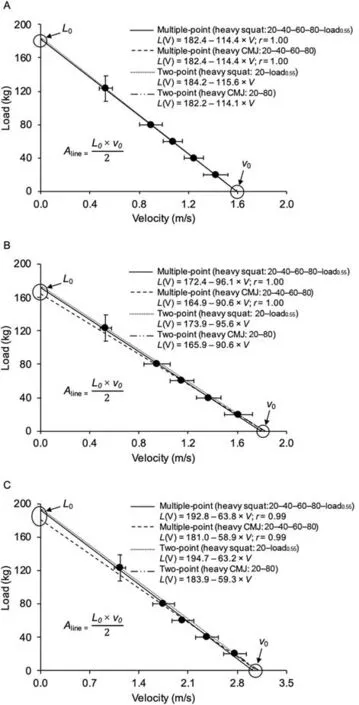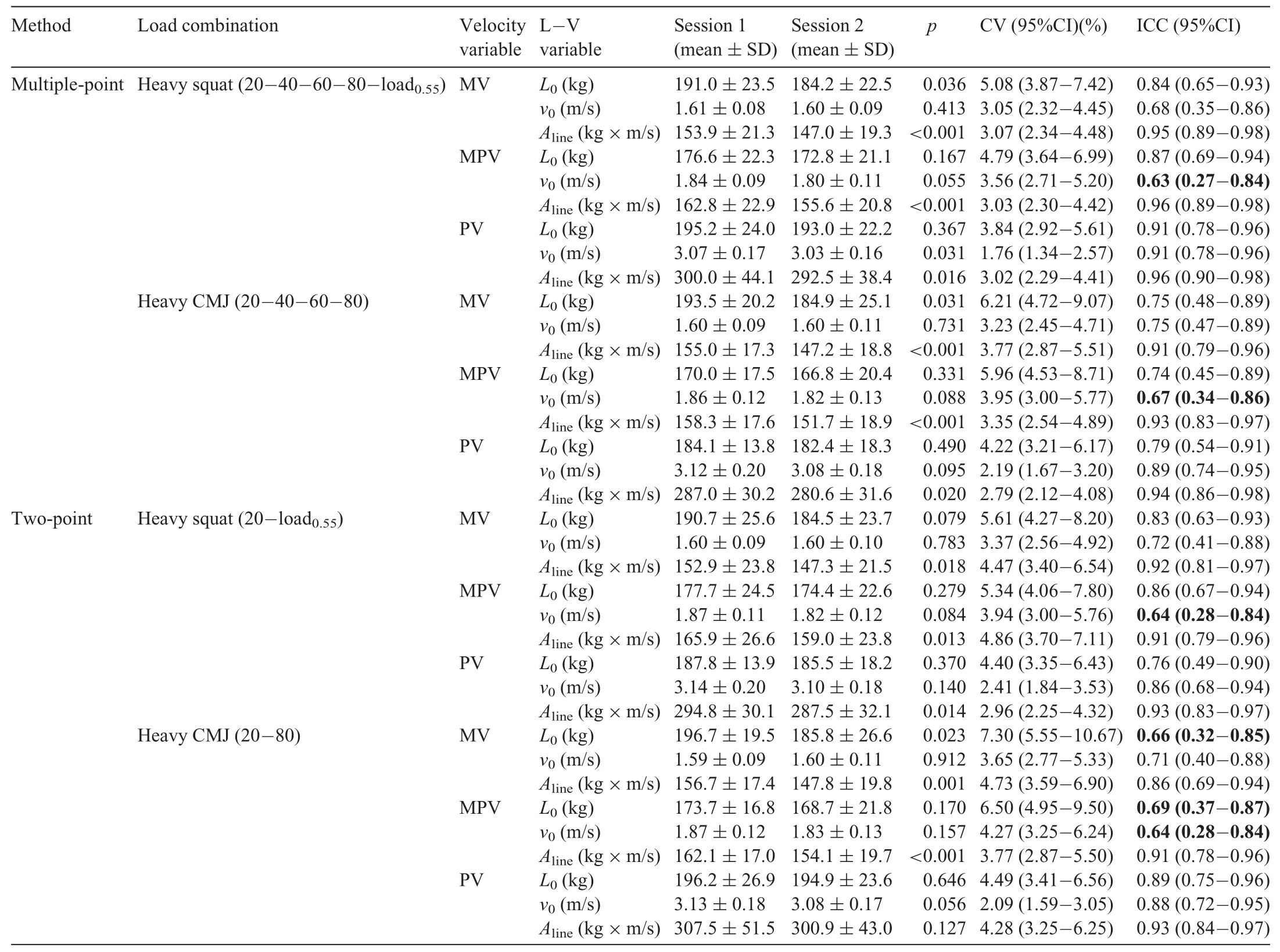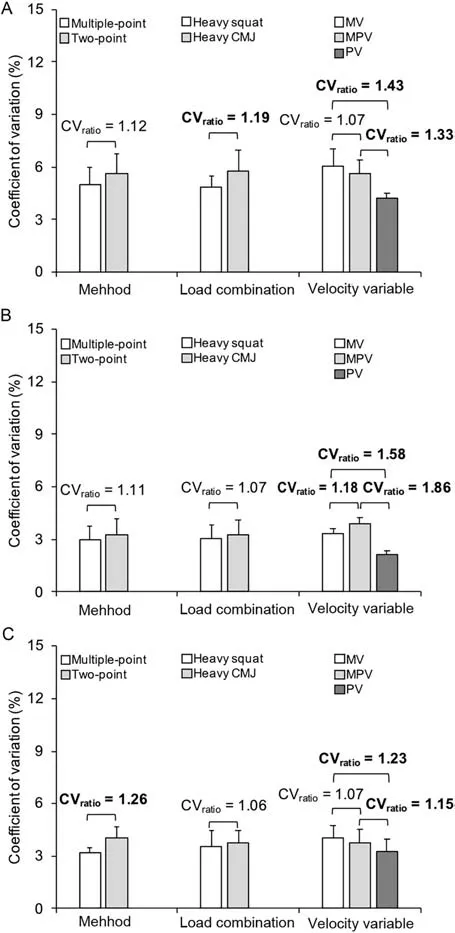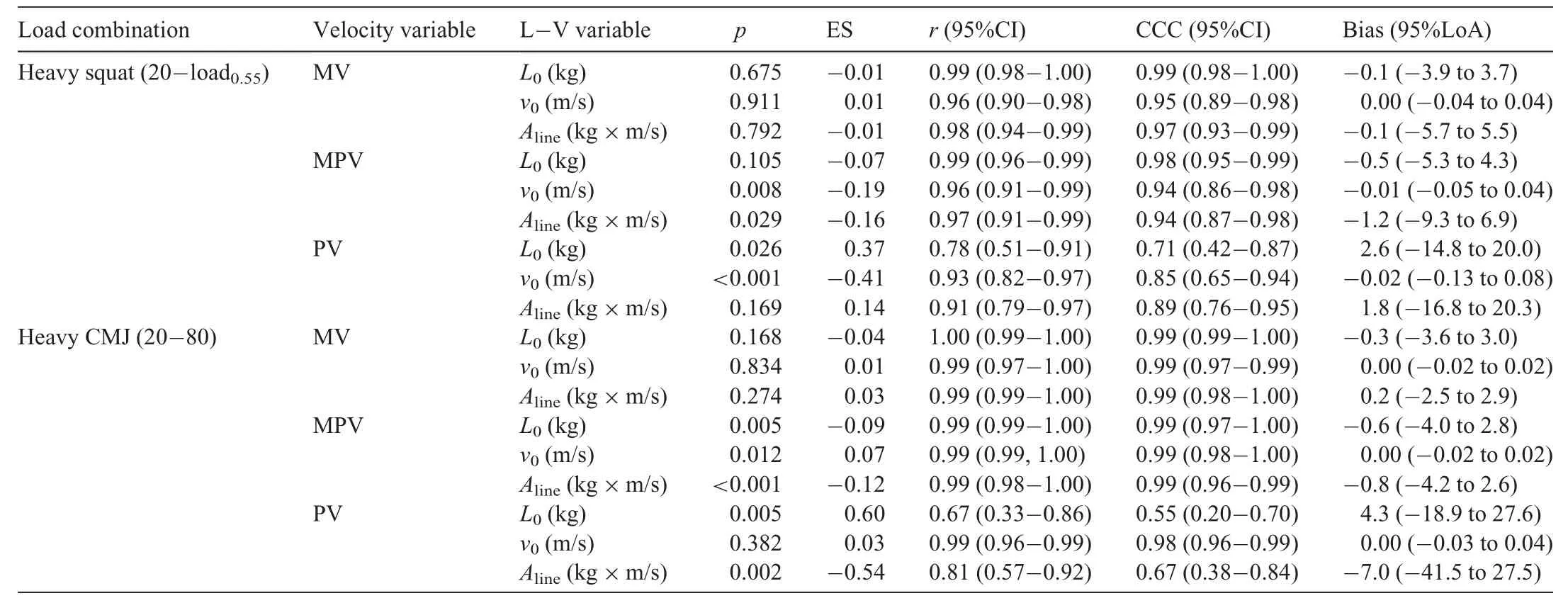Feasibility of the 2-point method to determine the load-velocity relationship variables during the countermovement jump exercise
2023-08-02AlejanrorezCastillaRorigoRamirezCampilloJohnFernanesAmaorGarcRamose
Alejanro Pérez-Castilla *,Rorigo Ramirez-Campillo ,John F.T.Fernanes ,Amaor García-Ramose
a Department of Physical Education and Sport,Faculty of Sport Sciences,University of Granada,Granada 18011,Spain
b Human Performance Laboratory,Department of Physical Activity Sciences,Universidad de Los Lagos,Santiago 5170000,Chile
c Centro de Investigación en Fisiología del Ejercicio,Facultad de Ciencias,Universidad Mayor,Santiago 8580745,Chile
d Higher Education Sport,Hartpury University,Hartpury GL19 3BE,UK
e Department of Sports Sciences and Physical Conditioning,Faculty of Education,Universidad Católica de la Santísima Concepción,Concepción 4090541,Chile
Abstract Purpose: This study aimed to examine the reliability and validity of load-velocity (L-V) relationship variables obtained through the 2-point method using different load combinations and velocity variables.Methods:Twenty men performed 2 identical sessions consisting of 2 countermovement jumps against 4 external loads(20 kg,40 kg,60 kg,and 80 kg)and a heavy squat against a load linked to a mean velocity(MV)of 0.55 m/s(load0.55).The L-V relationship variables(load-axis intercept (L0),velocity-axis intercept (v0),and area under the L-V relationship line (Aline)) were obtained using 3 velocity variables (MV,mean propulsive velocity (MPV),and peak velocity) by the multiple-point method including (20-40-60-80-load0.55) and excluding(20-40-60-80)the heavy squat,as well as from their respective 2-point methods(20-load0.55 and 20-80).Results:The L-V relationship variables were obtained with an acceptable reliability(coefficient of variation(CV)≤7.30%;intra-class correlation coefficient ≥0.63).The reliability of L0 and v0 was comparable for both methods (CVratio (calculated as higher value/lower value):1.11-1.12),but the multiple-point method provided Aline with a greater reliability(CVratio=1.26).The use of a heavy squat provided the L-V relationship variables with a comparable or higher reliability than the use of a heavy countermovement jump load (CVratio:1.06-1.19).The peak velocity provided the load-velocity relationship variables with the greatest reliability (CVratio:1.15-1.86) followed by the MV(CVratio:1.07-1.18),and finally the MPV.The 2-point methods only revealed an acceptable validity for the MV and MPV(effect size ≤0.19;Pearson’s product-moment correlation coefficient ≥0.96;Lin’s concordance correlation coefficient ≥0.94).Conclusion:The 2-point method obtained from a heavy squat load and MV or MPV is a quick,safe,and reliable procedure to evaluate the lower-body maximal neuromuscular capacities through the L-V relationship.
Keywords: Force-velocity relationship;Mean velocity;Multiple-point method;Peak velocity;Velocity-based training
1.Introduction
Velocity-based training has been popularized among strength and conditioning professionals due to its relevant and abundant practical applications1and to the increasing affordability of velocity monitoring devices.2For example,individualized load-velocity(L-V)relationships are used to regulate the training intensity,3,4quantify training-induced fatigue,5,6and assess changes in neuromuscular performance after training interventions.7,8Note also that individualized L-V relationships have been recommended over the generalized L-V relationship equations because the velocity associated with each relative load is subject-specific.2Furthermore,a novel application of the L-V relationship consists of determining the L-V relationship variables (load-axis intercept(L0),velocity-axis intercept (v0),and the area under the L-V relationship line (Aline=L0×v0/2)),which may be accurate indicators of the maximal capacities of producing force,velocity,and power,respectively.9In comparison to the force-velocity (F-V) relationship parameters (see Jaric10for further details),the assessment of the L-V relationship variables may be simpler and more reproducible because (a) the force output does not need to be computed for the modeling,and (b) the extrapolation needed from the experimental points tov0is reduced because only the external load lifted is considered for the analysis.However,little information is available in the literature concerning the reliability and concurrent validity of the L-V relationship variables.9
The countermovement jump (CMJ) is commonly used to evaluate neuromuscular function of lower-body muscles.11-13The CMJ testing procedures have typically consisted of the assessment of mechanical variables(force,velocity,and power)against individual loads.14,15More recently,the F-V relationship has been modeled through simple linear regressions by collecting force and velocity outputs against multiple loads(i.e.,multiple-point method).11,12,16,17However,since the F-V relationship in multi-joint tasks is highly linear,10it is generally accepted that the same F-V relationship parameters could be obtained more efficiently (i.e.,less time and fatigue) from the modeling of the force and velocity outputs against only 2 distant loads(i.e.,2-point method).18-20Specifically,in order to maximize the accuracy of the F-V relationship parameters in the CMJ exercise,the 2-point method should be based on the minimum possible loading condition and a CMJ against a load that allows reaching a jump height of about 10 cm.19Previous studies have sought to identify the optimal combination of experimental points(i.e.,loads)to determine the F-V relationship in exercises such as vertical jumping,19bench press throw,21or cycling.22However,no study has examined whether the 2-point method could also provide L-V relationship variables with an acceptable reproducibility and concurrent validity.For example,it could be of interest to examine the feasibility of 2-point methods differing in the magnitude of the heavy load(heavy squatvs.heavy CMJ)to determine the variables derived from the L-V relationship.
The determination of the F-V and L-V relationships require the assessment of lifting velocity under 2 or more loading conditions.23Therefore,another important factor that could affect the reliability of the outcomes of the F-V and L-V relationships is the velocity variable used.11,12For example,previous studies have shown that the F-V relationship parameters can be obtained with an acceptable reliability during the CMJ and squat jump (SJ) exercises using both the mean velocity (MV) and peak velocity (PV).11,12Although in the study of Cuk et al.,11the MV was shown to be more reliable than the PV,the study of García-Ramos et al.12reported contrasting results (i.e.,that PV was more reliable than MV).Moreover,a recent study by Kotani et al.24has discouraged the use of the F-V and L-V profiles to make training decisions because their outcomes obtained using both MV and PV were generally unreliable during the SJ exercise.These suggestions were made despite the fact that both velocity variables were obtained with a high reliability at each load and that the outcomes of the F-V and L-V profiles did not differ significantly between sessions.Indeed,all the aforementioned studies have used force platforms to determine these profiles.It should be noted that,compared to linear position/velocity transducers,the lower reliability of outputs obtained by force platforms could be due to the greater manipulation of raw data needed to obtain the variable of interest.25Therefore,further research is required to determine the between-session reliability of L-V relationship variables when velocity outputs are recorded with other devices such as linear position/velocity transducers,which are the technology most often used when implementing velocity-based training.1Since previous studies have shown a greater reliability for PV compared to MV and mean propulsive velocity (MPV) during the loaded CMJ and SJ exercises when recorded by linear position/velocity transducers across a range of loads,26,27it is also plausible that PV provides the variables derived from the L-V relationship with a higher reliability during jumping tasks.However,the lack of agreement in the literature highlights the need for further research on this topic.
To address the existing gaps in the literature,we assessed,on 2 separate occasions,the variables derived from the L-V relationship during the CMJ exercise using different load combinations and velocity variables.The main aim was to examine the between-session reliability and concurrent validity of the L-V relationship variables (L0,v0,andAline)obtained by different 2-point methods compared to their respective multiple-point methods.The secondary aims were to determine the effect of the magnitude of the heaviest load (heavy squatvs.heavy CMJ) and velocity variable (MVvs.MPVvs.PV)used for modeling the L-V relationships on the reliability of the L-V relationship variables.We hypothesized that the 2-point methods would provide the L-V relationship variables with high and comparable reliability to that of the multiple-point methods,and that their outcomes would be highly valid.18,19We also hypothesized a greater reliability(a) when using the heavy squat load compared to the heavier CMJ load due to a greater distance between the experimental points and increased proximity of the heavier experimental point toL0,19,21and (b) for PV compared to MV and MPV because PV can be obtained with a greater reliability during loaded vertical jumps.26,27
2.Methods
2.1.Subjects
Twenty resistance-trained men (age=22.2±1.8 years(mean ± SD),range: 20-26 years;stature=1.75±0.06 m;body mass=73.7±8.2 kg) volunteered to participate in this study.Prior to data collection,all subjects participated in a 4-week training program (8 sessions) in which they performed the CMJ exercise at maximal intended velocity.No physical limitations,health problems,or musculoskeletal injuries that could compromise testing were reported.Subjects were required to avoid any strenuous exercise over the course of the study,and they were informed of the procedures and signed a written informed consent form before initiating the study.The study protocol adhered to the tenets of the Declaration of Helsinki and was approved by the institutional review board (687/CEIH/2018).
2.2.Study design
A repeated-measures design was used to examine the between-session reliability and concurrent validity of the L-V relationship variables obtained by different 2-point methods with respect to their multiple-point methods during the CMJ exercise.Subjects were tested on 2 sessions separated by 7 days.Each session consisted of 2 CMJs against 4 external loads (20 kg,40 kg,60 kg,and 80 kg) and a squat against an estimated load equivalent to a MV of 0.55 m/s (load0.55).28Data from both sessions were used for reliability analyses,but only the data from the second session was used for validity analyses.Testing sessions were conducted at the University’s research laboratory at the same time of day for each subject(±1 h)and under similar environmental conditions(~22°C and~60% humidity).
2.3.Procedures
Each testing session began with a standardized warm-up consisting of 5 min of jogging at a self-selected moderate pace,dynamic stretching,joint mobilization exercises,and one set of 5 repetitions of the CMJ exercise performed with increasing effort against an external load of 20 kg(mass of the unloaded Smith machine barbell (Multipower Fitness Line;Peroga,Murcia,Spain)).After warming-up,subjects performed 2 CMJs against 4 external loads (20 kg,40 kg,60 kg,and 80 kg) and a squat against the load0.55(124.1±17.5 kg (range: 90-160 kg)).The MV collected under the 4 external loads was used to model the individualized L-V relationships by a linear regression model,and the load0.55was calculated in each session from these relationships as the load associated with an MV of 0.55 m/s (0.54±0.05 m/s(0.40-0.59 m/s)).An MV of 0.55 m/s was set to obtain an experimental point close toL0without exposing the subjects to the unnecessary risk of injury associated with maximal lifts.28The 5 loads were applied in an incremental order,and the rest period between the repetitions performed with the same and different loads was set to 1 min and 3 min,respectively.Subjects received velocity performance feedback immediately after completing each repetition to encourage maximal effort.29
The CMJ technique involved subjects standing with the knees and hips fully extended,feet approximately shoulder-width apart,and the barbell held across the top of the shoulders and upper back.Thereafter,subjects initiated a downward movement until reaching 90° knee flexion,followed immediately by a jump for maximum height.The execution technique for the load0.55was identical to the CMJ,involving upward movement at maximal intended velocity,although without lifting the toes off the ground.To ensure the 90° knee angle,subjects descended until touching an adjustable rod of a tripod with their glutei.30The 90°knee angle was individually measured with a manual goniometer(Pharmedic,Temuco,Chile),and the height of the tripod was recorded and maintained for both testing sessions.
2.4.Measurement equipment and data analysis
Stature (Seca 202 Stadiometer;Seca GmbH,Hamburg,Germany)and body mass(TBF-300A;Tanita Corp of America Inc.,Arlington Heights,IL,USA)were measured at the beginning of the first session.A Smith machine(Multipower Fitness Line;Peroga,Murcia,Spain)was used in all sessions coupled with a linear velocity transducer (T-Force System;Ergotech,Murcia,Spain) that directly sampled the velocity-time data at a frequency of 1000 Hz.Validity and reliability of the T-Force system have been reported elsewhere.31The T-Force software automatically calculated the 3 velocity variables: MV (i.e.,average velocity from the first positive velocity until the velocity is 0 m/s),MPV (i.e.,average velocity from the first positive velocity until the acceleration is lower than gravity(-9.81 m/s2)),and PV (i.e.,the maximum instantaneous velocity value reached during the upward movement).
The L-V relationships were calculated considering the 3 velocity variables(MV,MPV,and PV)using 4 load combinations: (a) multiple-point with heavy squat (i.e.,20-40-60-80-load0.55),(b)multiple-point with heavy CMJ(i.e.,20-40-60-80),(c) 2-point with heavy squat (i.e.,20-load0.55),and(d)2-point with heavy CMJ(i.e.,20-80).A least-square linear regression model (L(V)=L0-s×V) was used to determine the individualized L-V relationships,whereL0represents the load at 0 velocity andsis the slope of the L-V relationship.8Thev0andAlinewere then calculated as follows:v0=L0/sandAline=L0×v0/2.9Only the repetition with the highest velocity value at each load was used for modeling the L-V relationships.Therefore,12 L-V relationships(2 methods(multiple-point and 2-point)×2 load combinations (heavy squat and heavy CMJ)×3 velocity variables(MV,MPV,and PV))were obtained(Fig.1).

Fig.1.L-V relationships obtained from the data averaged across the subjects modeled by the different 2-point methods and their respective multiple-point methods using(A)the mean velocity,(B)mean propulsive velocity,and(C)peak velocity during the CMJ exercise.Mean values are shown for the 4 external loads(20 kg,40 kg,60 kg,and 80 kg) and load0.55,while the error bars represent the SD.Regression equations obtained from each individual method are also indicated(r,Pearson’s correlation coefficient).Aline=area under the L-V relationship line;CMJ=countermovement jump; L0=load-axis intercept;load0.55=estimated load equivalent to 0.55 m/s;L-V relationship=load-velocity relationship;v0=velocity-axis intercept.
2.5.Statistical analyses
Descriptive data are presented as mean ± SD and range.The normal distribution of the data was confirmed using the Shapiro-Wilk test (p>0.05).The strength of the L-V relationships modeled by the multiple-point methods was examined through the Pearson’s product-moment correlation coefficient(r).Paired samplesttests were used to compare the magnitude of the L-V relationship variables between both testing sessions.Between-sessions reliability was assessed by the coefficient of variation (CV=standard error of measurement/ subjects’ mean score×100) and intra-class correlation coefficient (ICC;Model 3.1) with their corresponding 95% confidence intervals(95% CIs).Acceptable reliability was determined as a CV <10% and ICC >0.70.19The ratio between 2 CVs was used to compare the reliability between the 2 methods(multiple-point and 2-point),2 load combinations (heavy squat and heavy CMJ),and 3 velocity variables (MV,MPV,and PV).The smallest important ratio between 2 CVs was considered to be higher than 1.15.27Paired samplesttests,Cohen’sdeffect size (ES),rcoefficients,and Lin’s concordance correlation coefficient (CCC) were used to assess the concurrent validity of the 2-point methods compared to their respective multiple-point methods.The criteria to interpret the magnitude of the ES was: trivial (<0.20),small (0.20-0.59),moderate (>0.59-1.19),large (>1.19-2.00),or very large(>2.00).32The strength of thercoefficients was interpreted as: trivial (0.00-0.09),small (>0.09-0.29),moderate(>0.29-0.49),high (>0.49-0.69),very high (>0.69-0.89),or practically perfect (>0.89).33The criteria to interpret the CCC were as follows: very poor (<0.70),poor (0.70-0.90),moderate (>0.90-0.95),good (>0.95-0.99),or very good(>0.99).34The 2-point methods were deemed to have an acceptable validity if the following criteria were met: from trivial to small ES (<0.20),from very high to practically perfect correlations (r>0.90),and from moderate to very good concordances(CCC >0.90).The agreement between the multiple-and 2-point methods was also quantified using the Bland-Altman 95% limits of agreement (LoA) technique(bias ±1.96×SD).Thercoefficients were also used to explore the association of the same L-V relationship variables obtained using different velocity variables.All reliability assessments were performed by means of a custom Excel spreadsheet,33while other statistical analyses were performed using the software package SPSS (Version 22.0;IBM Corp.,Armonk,NY,USA).Alpha was set at 0.05.Post hocstatistical power was conducted using G*Power(Version 3.1.9.6;https://www.psychologie.hhu.de/arbeitsgruppen/allgemeine-psychologie-und-arbeitspsychologie/gpower)with an ES of 0.5 and a of 0.05,and it revealed a 0.80 statistical power.
3.Results
All velocity variables reported an acceptable reliability for the 4 external loads (MV: CV=2.48% (95%CI:1.50%-2.99%),ICC=0.89 (95%CI: 0.80-0.96);MPV:CV=3.00% (95%CI: 2.31%-3.62%),ICC=0.86 (95%CI:0.73-0.94);PV: CV=1.76% (95%CI: 1.41%-2.02%),ICC=0.95 (95%CI: 0.91-0.97)).The strength of the individualized L-V relationships recorded from both multiple-point methods was practically perfect for the 3 velocity variables(MV:r=1.00 (95%CI: 0.98-1.00);MPV:r=1.00 (95%CI:0.97-1.00);PV:r=1.00(95%CI:0.98-1.00)).
The between-session reliability was generally acceptable forL0(CV=5.31% (95%CI: 3.84%-7.30%),ICC=0.80 (95%CI:0.66-0.91));v0(CV=3.12% (95%CI: 1.76%-4.27%),ICC=0.75 (95%CI: 0.63-0.91));andAline(CV=3.68% (95%CI:2.79%-4.86%),ICC=0.93(95%CI:0.86-0.96))(Table 1).The reliability comparisons revealed that (a) the multiple-point method provided a comparable reliability forL0(CVratio(caculated as higher value/lower value)=1.12) andv0(CVratio=1.11)and a greater reliability forAline(CVratio=1.26)compared to the 2-point method,(b) the heavy squat load provided a comparable reliability forv0(CVratio=1.07) andAline(CVratio=1.06)and a greater reliability for L0(CVratio=1.19)compared to the heavy CMJ load,and (c) the PV provided all L-V relationship variables with greater reliability than the MV and MPV (CVratio≥1.15),while the MV provided comparable reliability forL0andAline(CVratio=1.07)and a greater reliability forv0(CVratio=1.18)compared to the MPV(Fig.2).

Table 1 Between-session reliability of the L-V relationship variables obtained from different methods,load combinations,and velocity variables during the CMJ exercise.

Fig.2.Reliability comparisons between the different methods(multiple-point and 2-point),load combinations (heavy squat and heavy CMJ),and velocity variables (MV,MPV,and PV) for the (A) L0,(B) v0,and (C) Aline obtained during the CMJ exercise.Bars represent the average CV and their respective SD obtained combining the 2 load combinations and 3 velocity variables for the method,the 2 methods and 3 velocity variables for the load combination,and the 2 methods and load combinations for the velocity variable.Numbers depict the ratio between 2 CVs (CVratio=higher value/lower value),while meaningful differences in reliability (CVratio >1.15) are indicated in bold.Aline=area under the L-V relationship line;CMJ=countermovement jump;CV=coefficient variation; L0=load-axis intercept;L-V relationship=load-velocity relationship;MPV=mean propulsive velocity;MV=mean velocity;PV=peak velocity;v0=velocity-axis intercept.
The 2-point methods revealed an acceptable validity when compared to their respective multiple-point methods for MV and MPV (ES ranged -0.19 to 0.07;rranged 0.96-1.00;CCC ranged 0.94-0.99),but not for PV (ES ranged-0.54 to 0.60;rranged 0.67-0.99;CCC ranged 0.55-0.98) (Table 2).Finally,regardless of the method and load combination,the 3 L-V relationship variables revealed nearly perfect correlations between MV and MPV(r=0.98(95% CI:0.95-1.00)),and very high correlations between PV and MV (r=0.81 (95% CI:0.61-0.94)) and between PV and MPV (r=0.79 (95%CI:0.58-0.92)).

Table 2 Comparison of the L-V relationship variables obtained by different 2-point methods compared to their respective multiple-point methods for each velocity variable during the countermovement jump exercise.
4.Discussion
This study was designed to examine the between-session reliability and concurrent validity of L-V relationship variables obtained from the 2-point method with respect to the multiplepoint method during the CMJ exercise using different load combinations and velocity variables.The main findings of this study revealed that (a) the 3 L-V relationship variables were obtained with an acceptable reliability regardless of the method,load combination,and velocity variable;(b) both methods providedL0andv0with comparable reliability,but the multiplepoint method providedAlinewith a greater reliability;(c)the use of a heavy squat provided the L-V relationship variables with a comparable or higher reliability than the use of a heavy CMJ load;(d) the velocity variables could be ranked from the most to the least reliable as follows:PV >MV >MPV;and(e)both 2-point methods only revealed an acceptable concurrent validity when compared to their respective multiple-point methods for MV and MPV.These results suggest that the 2-point method obtained from a heavy squat load and MV or MPV is a quick,safe,and reliable procedure to evaluate the maximal neuromuscular capacities of lower-body muscles through the assessment of the L-V relationship variables.
It has been recently shown that the L-V relationship variables could be a simpler and more reproducible alternative than the F-V relationship parameters to estimate the upper-body maximal neuromuscular capacities.9However,further research is still needed to explore the reliability of this novel approach in other multi-joint tasks.Regardless of the method,load combination,and velocity variable,the results of the present study revealed that the 3 variables derived from the L-V relationship(L0,v0,andAline) offered an acceptable between-session reliability during the CMJ exercise.These results are in agreement with previous studies showing that the 3 F-V relationship parameters (force-axis intercept (F0),v0,and maximal power(Pmax)) can generally be obtained with acceptable reliability(CV ranged 2.4%-13.0%;ICC ranged 0.69-0.98) during CMJ and SJ exercises.11,12However,our results are in contrast to recent work that questioned the practical usefulness of the F-V and L-V profiles because their outcomes were not reliable (CV ranged 8.9%-39.4%,ICC ranged 0.03-0.92) during the SJ exercise.The discrepancy between the results of the present study and the Kotani et al.24is probably due to (a) the lack of familiarity of the subjects with the loaded SJ testing protocol(only 1 familiarization session),(b) the fatigue developed throughout the testing protocol (11 loading conditions),and (c)the device used to measure the velocity output (system centerof-mass velocity calculated from the force-time signal recorded by a force platform).Therefore,our study is the first to show that not onlyL0andv0,but also theAlinecan be obtained with acceptable reliability from the barbell’s velocity recorded by a linear velocity transducer during the loaded CMJ exercise.
One important aspect when determining the F-V and L-V relationships is to find a testing protocol that allows researchers to accurately determine their outcomes with minimum effort and time.23In partial support of our main hypothesis,the 2-point method generally revealed the L-V relationship variables to have a comparable between-session reliability and an acceptable concurrent validity in comparison to the multiple-point method when using mean velocities.These findings are in line with previous studies showing that the L-V relationship modeled through the 2-point methods can be used to estimate the one repetition maximum with high precision in various upper-body resistance training exercises.35,36More importantly,our results are in agreement with previous studies showing that the 2-point method is a reliable and valid procedure for the assessment of muscle mechanical capacities through the F-V relationship parameters obtained during the CMJ and SJ exercises.18-20Due to the high linearity of the L-V relationship (r≥0.97),it is evident that the addition of intermediate loads should not meaningfully improve the precision of the relationship modeling compared to using only the 2 most distant experimental points.23However,it is worth noting that the reliability of theAlinewas greater for the multiple-point method than for the 2-point method,likely because the error in determiningAlineis affected by the errors of bothL0andv0.Nonetheless,our study provides additional evidence that the 2-point method is not only a reliable and valid alternative to the multiple-point method when using mean velocities,but also a procedure for evaluating the lower-body maximal neuromuscular capacities through the L-V relationship obtained during the loaded CMJ exercise that is quicker and less prone to fatigue.
The distance between the 2 most distant experimental points and the proximity of the experimental points to the axis intercepts are 2 of the most important methodological factors for obtaining accurate F-V relationship parameters.23However,there is little information regarding the effect of the magnitude of the heaviest load in the modeling of the L-V relationship.Supporting our secondary hypothesis,the reliability of the L-V relationship variables was generally greater for the heavy squat load compared to the heavy CMJ load,likely due to the greater distance between the experimental points and increased proximity of the heavier experimental point toL0.These results arein agreement with Rivière et al.,37who found that the goodness of fit of the F-V relationship obtained during the loaded SJ exercise did not differ with or without inclusion of the squat one repetition maximum point.Similarly,these data agree with those of García-Ramos et al.19and Šarabon et al.,18who observed that the 2-point method based on the heavy CMJ load provided a high between-session reliability and concurrent validity with respect to the multiple-point method to determine the F-V relationship parameters during the SJ and CMJ exercises.In contrast,Šarabon et al.18found a poor-to-fair validity for the 2-point method based on an isometric maximal voluntary contraction task (squat exercise performed at 30°,60°,and 90°knee angles).Such discrepancies may be attributed partially to the different force production modalities that represent a dynamic(full range of knee extension) and isometric task(fixed knee angle).37In fact,it has been shown there is a weak association betweenF0and the maximal isometric voluntary contraction during the squat exercise.38Collectively,our results highlight that the 2-point method based on the heavy squat load is more reliable,equally valid,and potentially safer than the widely used 2-point method based on a heavy CMJ load.
A recent systematic review has shown that linear position/velocity transducers are the most used and accurate devices for measuring barbell velocity during resistance training.1Note that although both systems consist of a sensor with a cable attached directly to the collar of the barbell,the linear velocity transducer measures barbell velocity by recording electrical signals proportional to the cable extension velocity,while the linear position transducer measures barbell velocity from the differentiation of the cable displacement with respect to time.39The 3 velocity variables examined in this study (MV,MPV and PV) are commonly recorded through linear position/velocity transducers for modeling the F-V and L-V relationships.2,40However,no study has examined which velocity variable provides the outcomes of the L-V relationship with the highest reliability.Since previous studies have shown a higher reliability for PV compared to MV and MPV across a range of relative loads during CMJ and SJ exercises,26,27we hypothesized that PV would be the most reliable variable to determine the L-V relationship variables.Supporting our hypothesis,we found PV to be the most reliable variable,followed by MV and finally MPV.These results are in consensus with those of a previous study that examined the reliability of the velocity variables across the whole L-V relationship spectrum during the bench press throw exercise.40However,regardless of the load combination,the concurrent validity of the 2-point method with respect to multiple-point method was only found to be acceptable for MV and MPV variables.The lower concurrent validity observed for PV may be attributed to a lower linearity of the L-V relationship.40It is important to note that the L-V relationship variables obtained using the 3 velocity variables were strongly correlated (especially between MV and MPV).Therefore,since the 3 variables provide similar information,the MV could be recommended to obtain the L-V relationship variables during the CMJ exercise due to its greater reliability and concurrent validity.
There are several limitations that need to be acknowledged.First,the use of a relatively small sample size of resistancetrained men,all of whom were highly familiarized with the loaded CMJ performed at maximal intended velocity,makes the extrapolation of the present findings to less-skilled populations (e.g.,untrained subjects) challenging.Second,the generalizability of the current results may also be limited to the use of a Smith machine,which restricts the movement of the barbell to the vertical direction,as well as to the use of a linear velocity transducer.This is because the mechanical variables recorded by a linear velocity transducer during the CMJ exercise can be obtained with a somewhat higher reliability using a Smith machine compared to free-weights.25In addition,although the velocity measurements are highly related between force platforms and linear position/velocity transducers,41their outcomes should not be used interchangeably due to systematic differences.25Third,the minimum load was set to 20 kg (mass of the unloaded Smith machine barbell) to keep the same execution technique for all tested loads.It is possible that by including a jump against a very light load(e.g.,0.5 kg) and the reliability ofv0could be increased by reducing the extrapolation to the velocity intercept.Finally,the 2-point method was derived from a testing protocol based on multiple loads.Therefore,although a high reliability and validity of the F-V relationship parameters has been observed when the 2-point method was applied in field conditions (only 2 loads applied) in the leg cycle ergometer exercise,42further research is warranted to explore the feasibility of the L-V relationship variables when only 2 loads are applied in the testing protocol.
5.Conclusion
The 2-point method provided the L-V relationship variables with an acceptable reliability regardless of the load combination and velocity variable.However,the concurrent validity of the 2-point method with respect to the multiplepoint method was only acceptable for mean velocities.We recommend that practitioners use a heavy squat load and MV or MPV to model the L-V relationship through the 2-point method during the CMJ.Moreover,although L-V relationship variables (L0,v0,andAline) do not present clear physiological meaning,unlike the parameters derived from the F-V relationship (F0,v0,and Pmax),this novel approach can provide practitioners with a simpler and more precise alternative due to the lower number of mechanical variables included in the modeling (force output is not considered) and the lower extrapolation from the experimental points tov0(only the external load lifted is considered in the analysis).
Acknowledgment
We would like to thank all the participants who selflessly participated in the study.
Authors’contributions
APC contributed to the conception and design of the study,organized the database,performed the statistical analysis,and wrote the first draft of the manuscript;RRC and JFTF interpreted the data and drafted the manuscript;AGR contributed to the conception and design of the study,supervised the study,and drafted the manuscript.All authors have read and approved the final version of the manuscript,and agree with the order of presentation of the authors.
Competing interests
The authors declare that they have no competing interests.
杂志排行
Journal of Sport and Health Science的其它文章
- Exercise and quality of life in cancer
- The good,the bad,and the ugly of consumer sleep technologies use among athletes:A call for action
- Author biographies of EIC’s choice
- Indirect contact matters:Mid-flight external trunk perturbation increased unilateral anterior cruciate ligament loading variables during jump-landings
- Eccentric exercise-induced muscle weakness abolishes sex differences in fatigability during sustained submaximal isometric contractions
- Sports compression garments improve resting markers of venous return and muscle blood flow in male basketball players
